United States Coast Guard 2 (4/7)
Military Readiness
The Coast Guard, through its forefathers, is the oldest continuous seagoing service and has fought in almost every war since the Constitution became the law of the land in 1789. Following the War of Independence (1776-83), the Continental Navy was disbanded and from 1790 until 1798, when the U.S. Navy was created, the revenue cutters were the only national maritime service. The Acts establishing the Navy also empowered the President to use the revenue cutters to supplement the fleet when needed. Laws later clarified the relationship between the Coast Guard and the Navy.
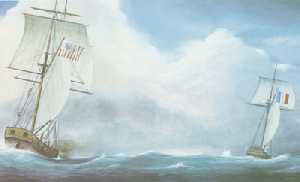
Right: the cutter Eagle captures the French privateer Bon Pere in April 1799
The Coast Guard has traditionally performed two roles in wartime. The first has been to augment the Navy with men and cutters. The second has been to undertake special missions, for which peacetime experiences have prepared the Service with unique skills. During the Quasi-War with France (1798-99), eight cutters operated along our southern coast in the Caribbean Sea, and among the West Indies Islands. Cutters captured 18 prizes unaided and assisted in the capture of two others. The cutter Pickering made two cruises to the West Indies and captured 10 prizes, one of which carried 44 guns and 200 men, three times her own force.
Augmenting the Navy with shallow-draft craft evolved out of the War of 1812 into a continuing wartime responsibility. During the opening phases of the war, Secretary of the Treasury Albert Gallatin addressed Congress. He said, "We want small, fast sailing vessels...there are but six vessels belonging to the Navy, under the size of frigates; and that number is inadequate." During the last two centuries, cutters have been used extensively in "brown water" combat. A cutter made the first capture of the war. One of the most hotly contested engagements was between the cutter Surveyor and the British frigate Narcissis. The Surveyor was captured. The British Captain wrote to Captain Samuel Travis on the following day:
"Your gallant and desperate attempt to defend your vessel against more than double your number excited such admiration on the part of your opponents as I have seldom witnessed, and induced me to return you the sword you so ably used in testimony of mine... I am at loss which to admire most, the previous arrangement on board the Surveyor or the determined manner in which her deck was disputed inch by inch."
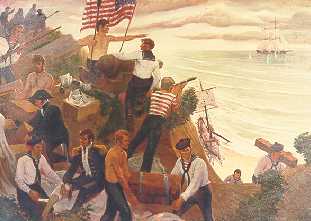
The defense of the cutter Eagle (right) against the attack of the British brig Dispatch and an accompanying sloop, is one of the most dramatic incidents of the War of 1812. The cutter was run ashore on Long Island. Her guns were dragged up on a high bluff and from there the crew of Eagle fought the British ships from 9 o'clock in the morning until late in the afternoon. When they had exhausted their shot, they tore up the ship's logbook as wads and fired back the enemy's shot that lodged against the hill. During the engagement, the cutter's flag was shot away three times and was as often replaced by volunteers from the crew on the hill. Finally, the British took the beached cutter with overwhelming numbers.
Revenue cutters fought a tenacious riverine war (1836-39) with the Seminole Indians in Florida. Cutters attacked parties of hostile Indians, broke up their rendezvous, picked up survivors of massacres, carried dispatches, transported troops, blockaded rivers to the passage of Indian forces, and landed riflemen and artillery for the defense of the settlements. These duties covered the whole coast of Florida. At the outbreak of the Mexican War (1846-48), the Navy was once again critically short of small steamers and schooners; cutters filled the void. Here, the shallow-draft revenue steamers assisted in amphibious operations against the Mexicans by towing ashore naval craft packed with Marines and seamen.
Military preparedness has never been limited to declared war. Second Lieutenant James E. Harrison, of the Revenue Cutter Jefferson Davis stationed in Puget Sound, accompanied Company C, 4th US Infantry, commanded by Lieutenant W. A. Slaughter, USA, during the Indian uprising in the state of Washington in 1855. The Service had been assisting the Army throughout the Puget Sound area and Harrison was acting as second in command. On December 3, while in camp, Indians ambushed the company and killed Lt. Slaughter, placing the command of a regular army company on Lt. Harrison. He immediately rallied the company and engaged in a hot firefight to beat off the attackers. Harrison then led his company back to Fort Steilacoom, arriving on 21 December 1855. In 1858, the cutter Harriet Lane was part of a naval squadron sent to blockade Paraguay.
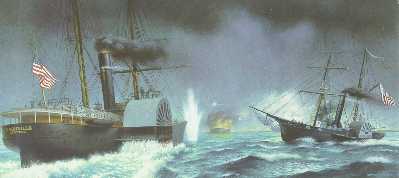
"If any man attempts to haul down the American flag, shoot him on the spot." Secretary of the Treasury John A. Dix telegraphed this message on the evening of January 15, 1861, attempting to retain under Federal control the cutter Robert McClellan, then lying in the port of New Orleans. As within the country, the sympathies of the cutter force were divided between the North and the South. Principal wartime duties of those cutters serving the Union were patrolling for commerce raiders and providing fire support of troops ashore; those serving the Confederacy were used principally as commercial raiders. Cutters were involved in individual actions. Harriet Lane, under the command of Captain John Faunce, fired the first naval shots of the Civil War. On 11 April 1861, she challenged the steamer Nashville with a shot across its bow (above, right). In December 1862, the cutter Hercules battled Confederate forces on the Rappahannock River. The cutter Miami carried President Abraham Lincoln and his party to Fort Monroe in May 1862, preparatory to the Peninsular Campaign. Cutter Reliance engaged Confederate forces on the Great Wicomico River in Virginia in 1864. Her commanding officer was killed in the action. On April 21, 1865, cutters were ordered to search all outbound ships for the assassins of the President.

In the Spanish-American War, cutters fought in the Caribbean and the Far East. Eight cutters, carrying 43 guns, were in Admiral William Sampson's fleet and on the Havana blockade. McCulloch, carrying six guns and manned by 10 officers and 95 crewmen, was at the battle of Manila Bay and, subsequently, was employed by Admiral George Dewey, USN, as his dispatch boat. At the battle of Cardenas, 11 May 1898, the cutter Hudson (above right) sustained the fight against the gunboats and shore batteries of the enemy side by side with the torpedo boat USS Winslow. When Ensign Bagley, USN, and half the crew had been killed and her commanding officer wounded, Hudson rescued the craft from destruction while under furious fire from the enemy's guns. In recognition of this act, Congress authorized that a gold medal be presented to Lieutenant Frank Newcomb, USRCS, a silver medal to each of his officers, and a bronze medal to each member of his crew.
Also during the Spanish-American War, the Navy assigned the coast watching mission to the U.S. Life-Saving Service. As a result, approximately two-thirds of the Navy's coastal observation stations along the coastline of the U.S. were Life-Saving Stations. At no time was the elusive Spanish fleet observed along our coastline, but the 24-hour-a-day job was accomplished by a Coast Guard predecessor.
On the morning of 6 April 1917, a coded dispatch was sent from Washington to every cutter and shore station of the Coast Guard. Within a few hours the entire Coast Guard, officers, and enlisted men, vessels, and units came under the operational control of the U.S. Navy. In August and September 1917 six Coast Guard cutters, Ossipee, Seneca, Yamacraw, Algonquin, Manning, and Tampa left the United States to join our naval forces in European waters. They constituted Squadron 2 of Division 6 of the Atlantic Fleet's patrol forces based at Gibraltar. Throughout World War I, they escorted hundreds of vessels between Gibraltar and the British Isles, and also performed escort and patrol duty in the Mediterranean.
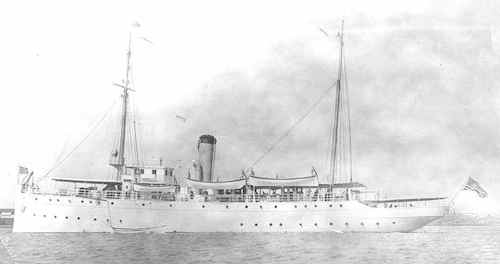
On the evening of 26 September 1918, Tampa (above) having acted as ocean escort for a convoy from Gibraltar to the United Kingdom, proceeded toward the port of Milford Haven, Wales. At 8:45 p.m. a loud explosion was heard. Tampa failed to arrive at her destination and a search was made for her by U.S. destroyers and British patrol craft. A small amount of wreckage was identified as belonging to the cutter and two unidentified bodies in naval uniforms were found. It was believed that Tampa was sunk by a German submarine. Every officer and enlisted man on board Tampa perished. There were 115 in all, 111 of whom were Coast Guard personnel. With the exception of U.S.S. Cyclops, whose fate has never been ascertained, this was the largest loss of life incurred by any U.S. naval unit during the war. The British Admiralty wrote to Rear Admiral William Sims, USN:
"Their Lordships desire me to express their deep regret at the loss of the U.S.S. Tampa. Her record since she has been employed in European waters as an escort to convoys has been remarkable. She has acted in the capacity of ocean escort to no less than 18 convoys from Gibraltar comprising 350 vessels, with a loss of only 2 ships through enemy action. The commanders of the convoys have recognized the ability with which the Tampa carried out the duties of ocean escort. Appreciation of the good work done by the U.S.S. Tampa may be some consolation to those bereft and their Lordships would be glad if this could be conveyed to those concerned."
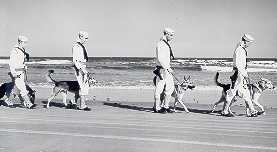
Right: Coast Guard beach patrol, circa 1942
Following the outbreak of war in Europe in 1939, the Coast Guard carried out neutrality patrols as set out by President Franklin D. Roosevelt on 5 September 1939. Port security began on 22 June 1940 when President Roosevelt invoked the Espionage Act of 1917 which governed the anchorage and movement of all ships in U.S. waters and protected American ships, harbors, and waters. Shortly afterwards, the Dangerous Cargo Act gave the Coast Guard jurisdiction over ships carrying high explosives and dangerous cargoes. In March 1941, the Coast Guard seized 28 Italian, two German, and 35 Danish merchant ships. A few days later, 10 modern Coast Guard cutters were transferred on Lend-Lease to Great Britain.

Right: The Spencer drops a depth charge on the German U-boat, 1943
On April 9, 1941, Greenland was incorporated into a hemispheric defense system. The Coast Guard was the primary military service responsible for these cold-weather operations, which continued throughout the war. On September 12 the cutter Northland took into "protective custody" the Norwegian trawler Buskoe and captured three German radiomen ashore. This was the United States' first naval capture of World War II.

Right: Coast Guard landing craft taking troops to Utah Beach during the Normandy Invasion, 1944.
The Coast Guard was ordered to operate as part of the Navy on 1 November 1941. During the war, Coast Guard-manned ships sank 11 enemy submarines. Coast Guard personnel manned amphibious ships and craft, from the largest troop transports to the smallest attack craft. These landed Army and Marine forces in every important invasion in North Africa, Italy, France, and the Pacific. Coast Guard coastal picket vessels patrolled along the 50- fathom curve, where enemy submarines concentrated early in the war. While onshore, armed Coast Guardsmen patrolled beaches and docks, on foot, on horseback, in vehicles, with and without dogs, as a major part of the nation's anti-sabotage effort.
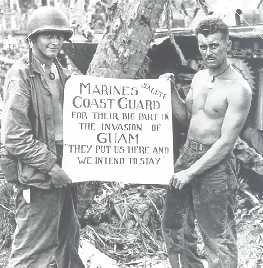
Right: Marines salute the Coast Guardsmen who put them ashore during the invasion of Guam, 1944.
Coast Guard craft rescued more than fifteen hundred survivors of torpedo attacks in areas adjacent to the United States. Cutters on escort duty saved another one thousand and over fifteen hundred more were rescued during the Normandy operation. During the war the Coast Guard-manned 802 cutters (those over 65 feet in length), 351 naval ships and craft, and 288 Army vessels. Almost two thousand Coast Guardsmen died in the war, a third of those in action. Almost two thousand Coast Guardsmen were decorated, one receiving the Medal of Honor, six the Navy Cross, and one the Distinguished Service Cross. The Coast Guard returned to the Treasury Department on Jan. 1, 1946.
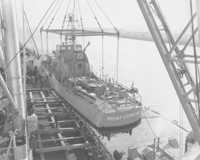
Right: Point Cypress is loaded onto a merchant vessel for the trip to Asia
The Service performed primarily a supporting role during the Korean Conflict. Its principal contributions were improving communications and meteorological services plus assuring port security and proper ammunition handling. The Coast Guard also served in Vietnam performing duties uniquely suited to the specialized skills of the Service. In 1965, 26 82-foot Coast Guard cutters were ordered to Vietnam.

Right: the Point Young on an Operation Market Time-patrol
These were used in the "brown water" war, attempting to interdict Vietcong and North Vietnamese infiltration and logistics. In 1966 the first ocean-going cutters augmented the Navy and Coast Guard surveillance forces already in Vietnam. Coast Guardsmen were also detailed to improve port security, especially in Saigon, to assist with problems involving the Merchant Marine, and to teach workmen the basics of safe handling of ammunition and other dangerous cargoes. An in-country navigation system was created and a Loran network was set up for Southeast Asia. "Vietnamization" began in February 1969 and was concluded by December 1971. In all, 56 Coast Guard cutters served in Vietnam.
With the Iraqi invasion of Kuwait on 1 August 1990, the Coast Guard was again called to perform military duties. On 17 August 1990, at the request of the Joint Chiefs of Staff, the Secretary of Transportation and the Commandant of the Coast Guard commit Coast Guard law enforcement boarding teams [LEDETs] to Operation Desert Shield. A total of 10 four-person teams served in theatre to support the enforcement of UN sanctions by the Maritime Interdiction Forces. Approximately 60 percent of the 600 boardings carried out by U.S. forces were either led by or supported with the USCG LEDETs. Additionally, a 7-man liaison staff was designated by the Commandant as Operational Commander for the USCG forces deployed in theatre. The first boarding of an Iraqi vessel in the theatre of operations conducted by a USCG LEDET occurred on 30 August 1990.
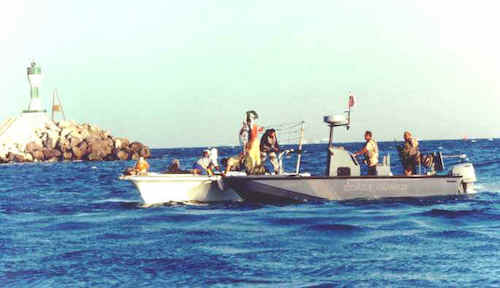
President George H. W. Bush, on 22 August 1990, authorized the call up of members of the selected reserve to active duty in support of Operation Desert Shield. Three port security units (PSUs), consisting of 550 Coast Guard reservists are ordered to the Persian Gulf in support of Operation Desert Shield. (This was the first involuntary overseas mobilization of Coast Guard Reserve PSUs in the Coast Guard Reserve's 50-year history). A total of 950 Coast Guard reservists are called to active duty. Other reservist duties included supervising RRF vessel inspection and loading hazardous military cargoes. On 15 September 1990 the Secretary of Transportation and the commandant committed the first-ever deployment of a Coast Guard Reserve port security unit overseas, Port Security Unit 303. Prior to the launch of Operation Desert Storm, Coast Guard LEDET personnel on board the USS Nicholas (FFG-11) assisted when the frigate cleared eleven Iraqi oil platforms and took 23 prisoners on18 January 1991. On April 21, 1991, a Tactical Port Security Boat (TPSB) of PSU 301, stationed in Al Jubayl, Saudi Arabia, was the first boat in the newly reopened harbor of Mina Ash Shuwaikh in Kuwait City. Because of certain security concerns, a determination was made to send one of the 22-foot Raider boats belonging to PSU 301 and armed with .50 caliber and M60 machine guns, to lead the procession into the harbor and provide security for the festivities.
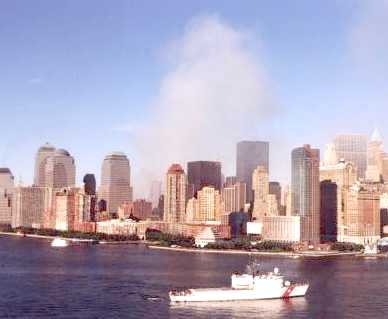
Right: The Tahoma controls vessel traffic in New York harbor while the World Trade Center complex burns in the background
On 11 September 2001, terrorists from Osama bin Laden's Al Qaeda network, hijacked four commercial aircraft, crashing two into the World Trade Center in New York and one into the Pentagon in Washington, DC (the fourth aircraft crashed around Shanksville, PA when passengers on board tried to regain control from the terrorists). USCG units from Activities New York were among the first military units to respond in order to provide security and render assistance to those in need.
In response to the terrorist threat and to protect our nation's coastline, ports and waterways, six U.S. Navy Cyclone-class patrol coastal warships were assigned to Operation Noble Eagle on 5 November 2001. This was the first time that U.S. Navy ships were employed jointly under Coast Guard command.
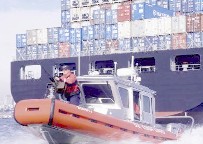
Right: A Maritime Safety and Security Team patrols a major U.S. port. MSSTs were established to ensure the safety of US ports.
In the aftermath of the terrorist attacks President George W. Bush proposed the creation of a new Cabinet-level agency, eventually named the Department of Homeland Security. The Coast Guard was foremost among the agencies slated to become a constituent of the new department. On 25 November 2002, President Bush signed HR 5005 creating the Department of Homeland Security. Soon after, Tom Ridge, former governor of Pennsylvania, was confirmed as the department's first Secretary. On 25 February 2003, Transportation Secretary, Norman Mineta transferred leadership of the U.S. Coast Guard to Secretary Ridge, formally recognizing the change in civilian leadership over the Coast Guard and ending the Coast Guard's almost 36-year term as a member of the Department of Transportation.

Right: USCGC Wrangell escorts the British vessel Sir Galahad into Iraqi waters
As a prominent member of the new department, US Coast Guard units deployed to Southwest Asia in support of the US-led coalition engaged in Operation Iraqi Freedom early in 2003.
